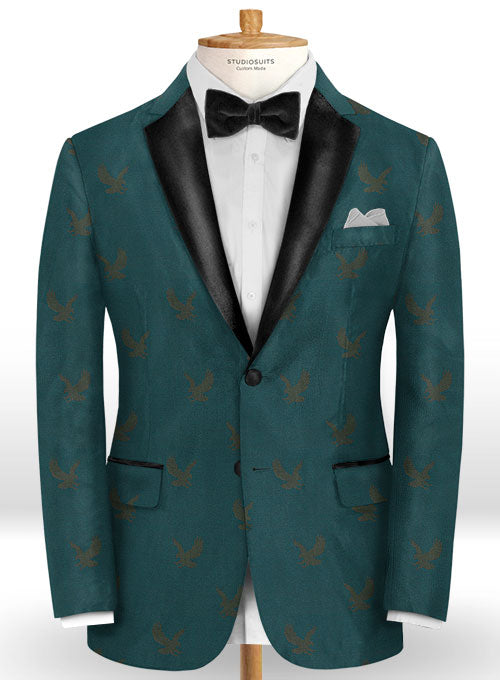Lapels are a common feature on suit jackets. While there are dozens of types of suit jackets, nearly all of them have two lapels. You can find them on the front of a suit jacket. One lapel runs vertically on the right-front side, whereas the other lapel runs vertically on the left-front side. When combined, they help to create a more formal and fashionable style. What are lapels exactly, and how do you know which lapels to choose when shopping for a suit jacket?
Overview of Lapels
Lapels are essentially folded bands of fabric found on the front of a suit jacket. All suit jackets have lapels. Whether it’s a cotton, linen or wool suit jacket, it will likely have a pair of lapels.
When manufacturers make suit jackets, they create two lapels. The lapels are typically made of the same material as that of the suit jacket. Cotton suit jackets, for instance, have cotton lapels, whereas wool suit jackets have wool lapels. Lapels are an extension of a suit jacket’s fabric. They are vertical bands of fabric that manufacturers fold and sew into place.
Purpose of Lapels
Being that they are nothing more than folded bands of fabric, you might be wondering what purpose lapels serve. Lapels don’t serve any functional purpose. Rather, they are used for aesthetic purposes.
With lapels, suit jackets offer a more formal style that’s synonymous with men’s formalwear. They add an invaluable touch of formality to suit jackets that lifts their aesthetics. If you’re getting dressed for a formal event, you need to choose a suit jacket with lapels. Lapels are a vital component in formal outfits. You’ll struggle to create an attractive and formal outfit without them.
Lapels can also help to define your figure. Since they run vertically, they’ll create the perception of a taller and slimmer figure. They won’t necessarily make you taller or slimmer. Nonetheless, lapels create the illusion of a taller and slimmer figure. The bottom line is that lapels are used for aesthetic purposes in suit jackets.

Comparing the Different Types of Lapels
While all lapels consist of a folded band of fabric, they are available in several types. Perhaps the most popular type is notched. Also known as step-collar lapels in the United Kingdom, notched lapels are used almost exclusively on single-breasted suit jackets. If you own a single-breasted suit jacket, it probably has notched lapels. They are called “notched lapels” because they are sewn into the collar at an angle, thereby creating a notch on each side of the collar.
In addition to notched, there are peaked lapels. When compared to notched lapels, peaked lapels are more formal. Peaked lapels have a more intricate design that’s characterized by sharp and well-defined corners. Most double-breasted suit jackets have peaked lapels. They are wider than notched lapels, making them ideal for double-breasted suit jackets.
A third type of lapel is shawl. Also known as roll collar lapels, shawl lapels have been around for over a century. During the Victorian Era, they were used on men’s dinner jackets as well as other informal and semi-formal jackets. Since then, shawl lapels have made their way into traditional suit jackets. They aren’t as common as notched or peaked lapels. Regardless, you can still find many suit jackets featuring shawl lapels. Shawl lapels are simple, uniform and attractive.
Tuxedo Lapels: What You Should Know
It’s important to note that tuxedo jackets have slightly different lapels than traditional suit jackets. Tuxedo jackets are still available in the same lapel types as traditional suit jackets, including peaked, notched and shawl. The difference is that tuxedo jackets have a layer of satin on their lapels.
If you inspect the lapels on a tuxedo jacket, you’ll probably notice that it has a softer and smoother texture than the rest of the jacket. This is because tuxedo jackets are designed with satin-covered lapels. The lapels are still made of the same fabric as the rest of the tuxedo jacket, but they are covered in satin. Traditional suit jackets, on the other hand, don’t have satin-covered lapels.
With satin-covered lapels, tuxedo jackets have a slightly different appearance than traditional suit jackets. The satin creates a shiny appearance that makes them stand out.
How to Maintain Lapels
You should maintain the lapels on your suit jacket to protect them from damage as well as premature wear and tear. Lapels aren’t immune to damage. Like all parts of a suit jacket, they can sustain damage, or they can degrade. Fortunately, you can preserve your suit jacket’s lapels by maintaining them.
Lapels can attract dirt and stains. And since they are located on the front of a suit jacket, lapels show stains more easily than other parts. If you notice a stain on your suit jacket’s lapels, you should clean it. Don’t just toss your suit jacket in the washing machine. Instead, check the care tag for instructions on how to properly clean it. Different suit jackets require different steps to clean. By referring to the care tag, you can rest assured knowing that you are using the right method to clean the lapels.
Lapels can also develop wrinkles. Wrinkles, in fact, are relatively common on lapels. Whether they are peaked, notched or shawl, all lapels consist of a vertical band of folded fabric. These folded sections of fabric can inevitably develop wrinkles.
To protect against wrinkles, be sure to hang up your suit jacket when you aren’t wearing it. Storing your suit jacket on a clothes hanger will allow it to drape naturally so that it retains its original shape. In turn, wrinkles are less likely to develop on or around the lapels.
You can also smooth out wrinkles by using a garment steamer or an iron. Of those two devices, the former is recommended. A garment steamer uses heat and moisture to gently lift wrinkles out of garments. As you run the garment steamer over the lapels, it will smooth out the fabric while subsequently eliminating wrinkles.



